There are moments in time that you can easily identify as pivotal. They are the ones that shine bright and strong in the deepest pockets of our memories. And they are the ones that immediately stir soulful happiness in our hearts. Taking a marbling class from Pat K. Thomas is one of those pivotal moments for me. Pat was the second teacher I studied with (and whom I ended up taking two classes from because she had that much impact on me) and her calm, confidence, and sense of adventure in the tank is something I admire so greatly. She’s one of the most consistent marblers I’ve seen, nailing traditional patterns and creating unique designs with an elegance, grace, and charisma like no one else I’ve witnessed. She always has a smile on her face when at the tank and energy to match. And it is her ability to break down the nuances of each stroke in a pattern that helped shape the way I looked at my tools, tank, bath, and paints and their relationship to my movements. In fact, as I was working on this interview with her, I realized she has also had an influence on a large part of my teaching style for that very reason.
With over 25 years at the marbling tank, a keen sense of observation, and a fresh spirit, the marbling community is so lucky to have Pat as a resource and ambassador of the art form in both its traditional and contemporary forms. Read on to learn more about her marbling journey.
Tell us about the first time you were exposed to marbling. What attracted you to the art form and why were you compelled to learn how to do it?
The first live demonstration of marbling I witnessed was in historic Williamsburg, Va. in the late ‘80s. In the Print Shop, a gentleman in Colonial garb was pulling these wonderful patterned papers from a battered, dull copper vat. The papers and the process immediately appealed to me. Unfortunately, this was before the advent of personal computers and the ever-helpful Google. It was difficult to track down the odd materials necessary for marbling.
Arrowmont School of Arts and Crafts in Gatlinburg, Tenn., which is right near me, offered a marbling class taught by Mimi Schleicher in 1990. I was hooked immediately! There was no turning back! Mimi’s mother, Patty Schleicher, traveled to the class to teach an impromptu book binding session. I still hear her voice telling all of us to brush glue from the middle gently out to the edges of the covers of our first books. I had always been attracted to letter forms, old books, and all things paper, so marbling encompassed all this for me.
After Mimi’s workshop, I ordered the elusive materials: ox gall, watercolor marbling paints, carrageenan, and aluminum sulphate. I mixed it all up and remember standing behind a brand new wooden tray and wondering, “What do I do now!?!?” Eventually, after much experimentation and many terrible papers, a rhythm developed. Stones, Gelgit, Nonpareil, adapt, repeat. The steps were comforting, the consistency of results was encouraging, the range of colors and patterns were seemingly endless, the reoccurring air bubbles were continuously frustrating.
How has the art form changed from the days when you first started marbling? What is the most noticeable difference in marbling today from when you first started marbling?
Marbling is one giant science experiment. I made a transition from the paints I learned to marble with to Golden Fluid Acrylics. I dropped the nasty ox gall to the new equivalent of Golden’s Acrylic Flow Release, which I believe has been renamed as a Wetting Agent. I never did like the stirring the clay bodies that settled at the bottom of the open jars. I prefer my paints in plastic squeeze/shaker bottles. The acrylics stay suspended over time (except for the blues).
How would you describe your marbling style (i.e. traditional, contemporary, experimental, modern, etc.) and why do you approach the art form that way?
My marbling style is all across the spectrum. I am happy marbling traditional patterns all day long. Some days, I am ecstatic to create lots of border white space and marble just the essence of a contemporary interpretation of a pattern. I marble paper, silk scarves, leather, three-dimensional objects. I’m always expanding my expertise for my own growth and for the students I teach.

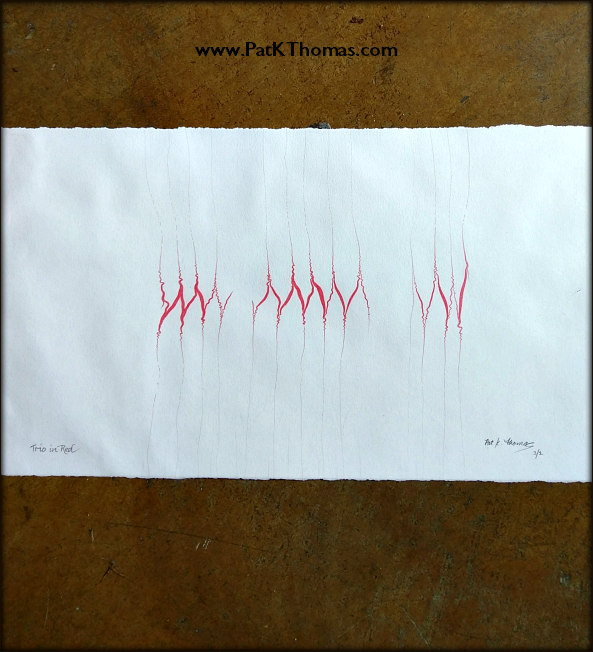
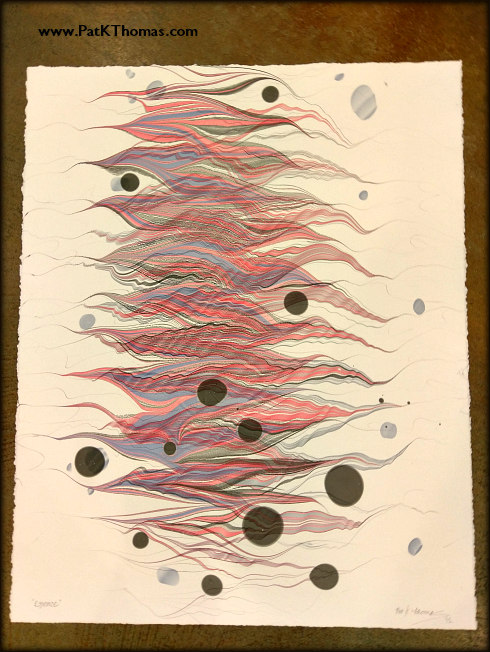
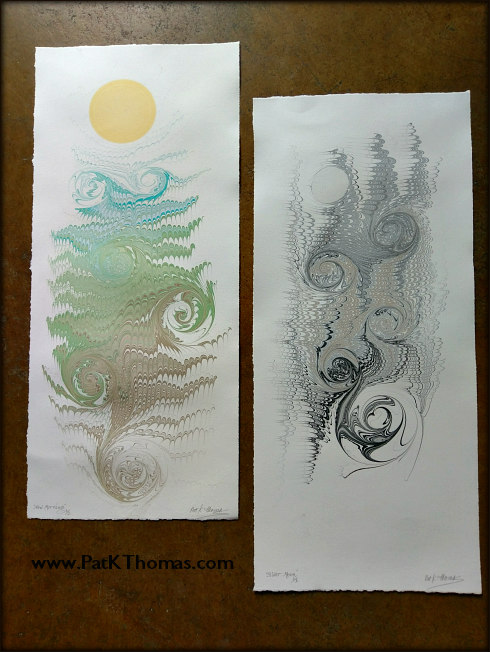
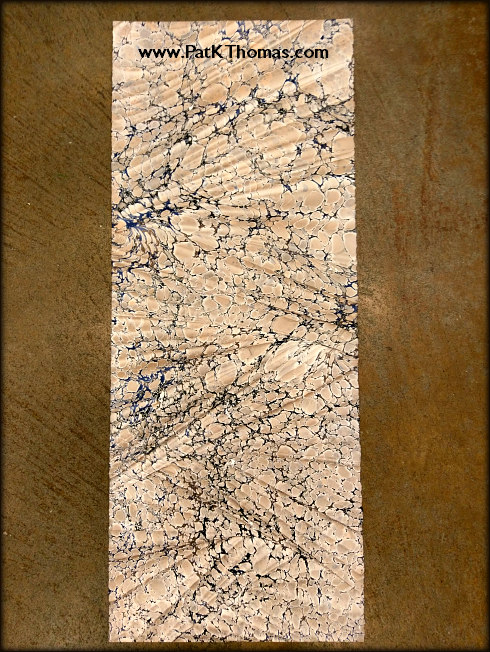


One of the things I really admire about you is the way you bring marbling into other creative endeavors. You recently taught a class at Arrowmont School of Arts and Crafts on marbling on alternative surfaces (beyond regular paper). In addition, you’ve incorporated marbling into your contemporary fine art pieces. How does marbling on non-traditional surfaces and for non-traditional uses (beyond bookbinding) change the way you approach the marbling tank? In other words, how is it different for you than marbling on paper? Walk us through your thought process.
Marbling Alternative Surfaces is a workshop I developed because of woodturners’ interest in marbling their 3D wood pieces. Whenever Rudy Lopez, woodturner and instructor, and I taught the same week, we marbled wood pieces. I’ve given several demonstrations to woodturner groups, so it was time to offer an official class. I’ve taught the class twice so far and am amazed at the variety of alternative surfaces students tried: shells, shoes, bisqueware, cork, leather, wood, leaves, lampshades, papier mâché. Great fun! I imagine a 3D object flattened out, like the old orange-peel maps of the world in the back of social studies books. This estimate determines the size of the tray. I use square planters, 10" x 10" x 10" for small objects and 16" x 16" x 16" for larger objects. Simple patterns such as Stone or Gelgit translate best on 3D objects. For wood, I prefer earthy colors and metallics. Marbling 3D objects requires a lot of size to be made since the marbler needs depth as well as surface.
When I marble my mixed-media art pieces, I use half of my 80" x 18" scarf tray. The art pieces are usually 11-12" x 30-36". I use high-quality print paper or watercolor papers. I love to preserve the deckle edges of the papers. The heavier papers allow multiple movements in a multi-axis moiré pattern. Paired with polished sliced agates, bleached shells and corals, or interesting drift wood, the finished wall art is both contemporary and organic.
Initially, I loved my contemporary pieces as large as the paper dimensions and tray would allow, but currently I am adjusting the sizes to a smaller version. The large 24" x 30" pieces are morphing into 9" x 20" and the 12" x 32" size is changing to a 8" x 16". Not everyone has the wall space for the full-size pieces, so I listen and adapt my work.
Recently, I had a dream of another type of mixed-media piece that features marbling as a base and layers other techniques over and over again. In the dream it looked great! I can’t wait to try it!
Each type of marbling is basically the same, with differences to be adjusted according to the material being marbled. I use the same paint and carrageenan mixture for all my marbling. I no longer mix in an additive for fabric after experimenting with one and not feeling a discernible difference.
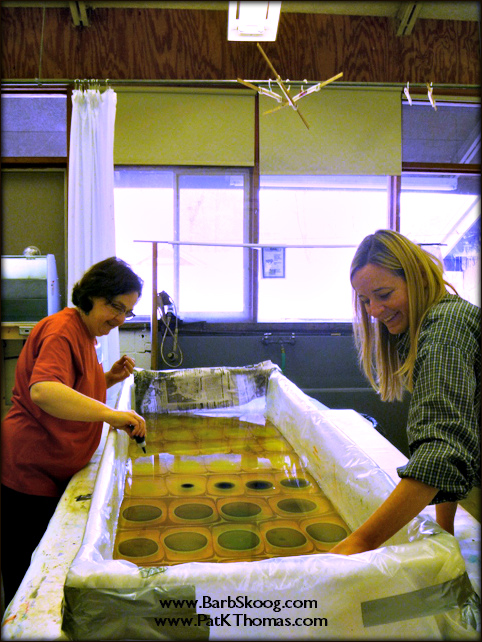


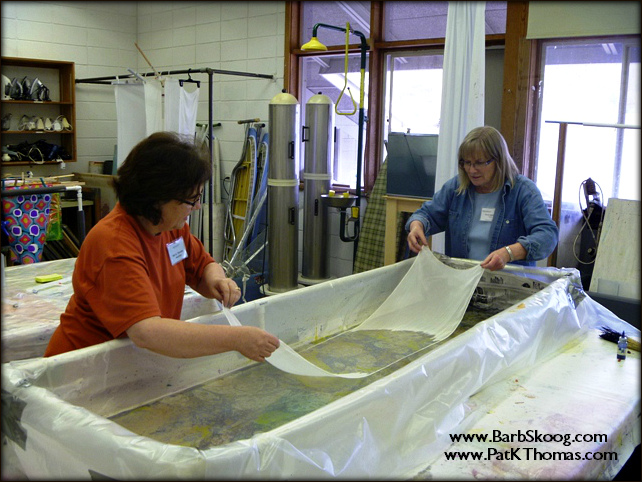
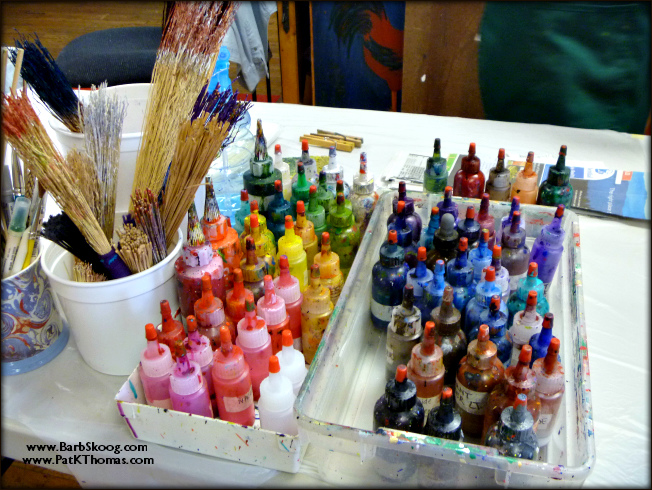
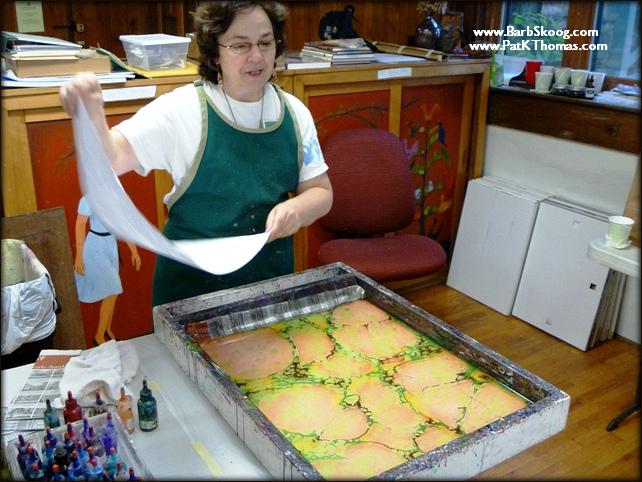
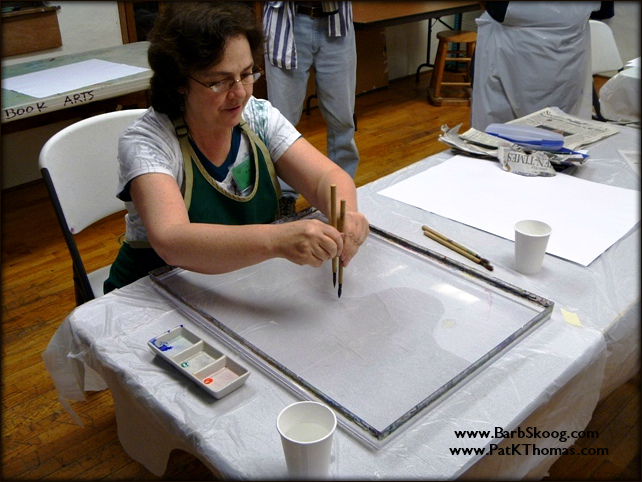
As one of my first marbling teachers, I admire your teaching style and have modeled my own classroom style after you. What do you like about teaching?
Teaching is a way to continue the art of marbling to an entirely new group of people. Some may never marble again outside of the class, but many have launched their own marbling careers after taking a one. This is very gratifying to me as a teacher.
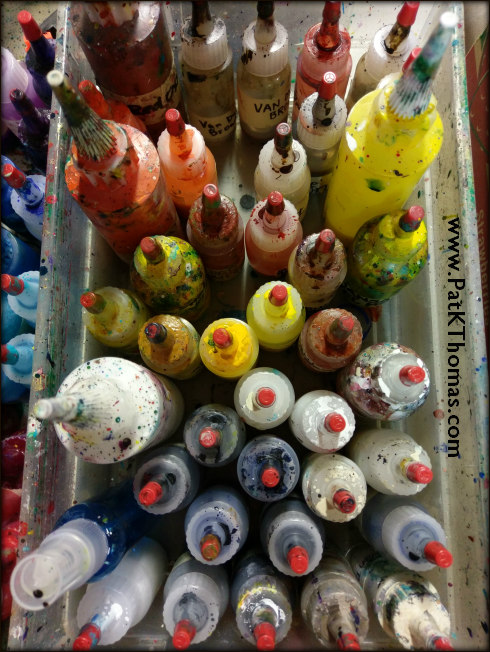
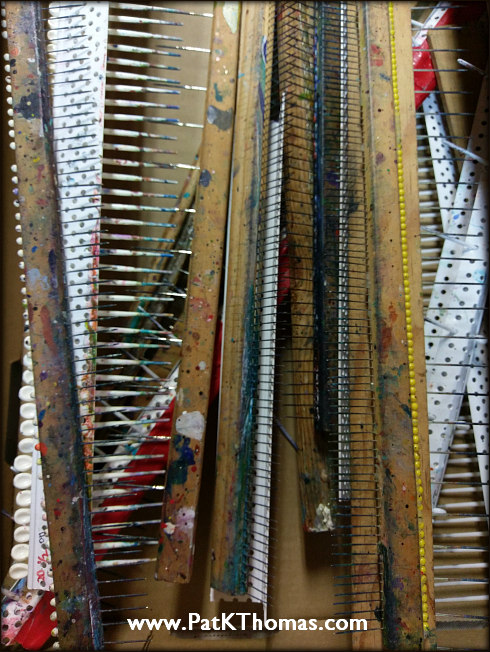
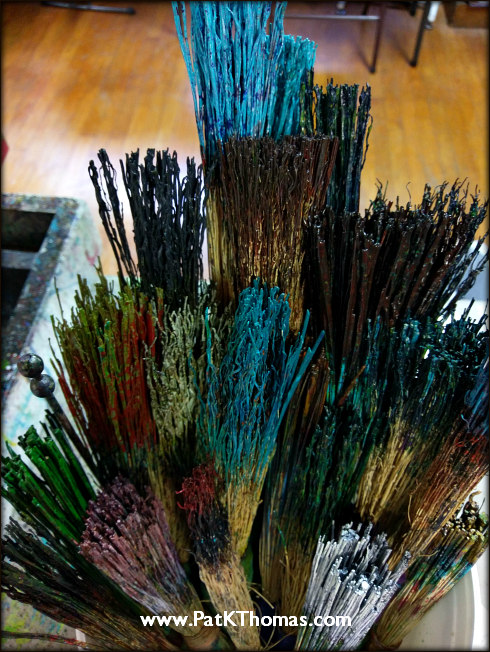
You are a prolific teacher, leading a wide variety of classes in many different locations. Where do you teach and what kind of classes do you conduct?
Private or small group instruction is taught in my studio in Gatlinburg, Tenn. and tailored to the wants of the students. I also teach at John C. Campbell Folk School in Brasstown, N.C., Arrowmont School of Arts and Craft in Gatlinburg, Tenn., event centers, other regional art schools, and by invitation to various groups and conferences. I teach a variety of classes from beginning paper marbling and silk scarf/fabric marbling to an historic cultural approach to marbling and marbling and bookbinding, including miniature marbling for miniature bookbinding. I’d like to teach a totally experimental marbling class to marblers with experience. We’ll see if that can happen!
Tell us about Cliff Dwellers Gallery in Gatlinburg, Tenn., which is where your marbling studio is located, and your experience with the other artists working there and the public who visits.
My marbling studio is in the 1940s upstairs living room of Cliff Dwellers Gallery. An artist, Louis Jones, built the two-story shop and living quarters in downtown Gatlinburg just as the Great Smoky National Park was established in 1934. He and his wife, Emma, lived upstairs and ran the downstairs gallery. In 1994, the building was moved to the Great Smoky Arts and Craft Community in Gatlinburg and we re-opened in May 1996.
Myself and three women artists cooperatively own the Gallery. We maintain open studios when we work upstairs. Visitors get to see the magic of marbling firsthand and I wind up explaining marbling in fifty words or less to each new group. For most people, this is their first experience with marbling. Some have subsequently been interested enough to sign up for classes.
It makes my day when a visitor is excited to see marbled papers available! To me, my marbled papers are complete when they become someone’s finished art project. It is great fun to hear the wide spectrum of projects the papers become part of, everything from family cookbook covers, fireplace mantels, and background cabinet decorations for Fiestaware dishes to lots of cards and paper projects!
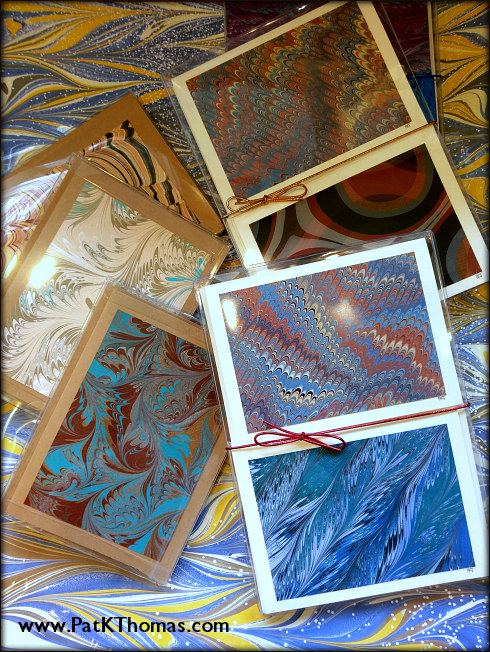
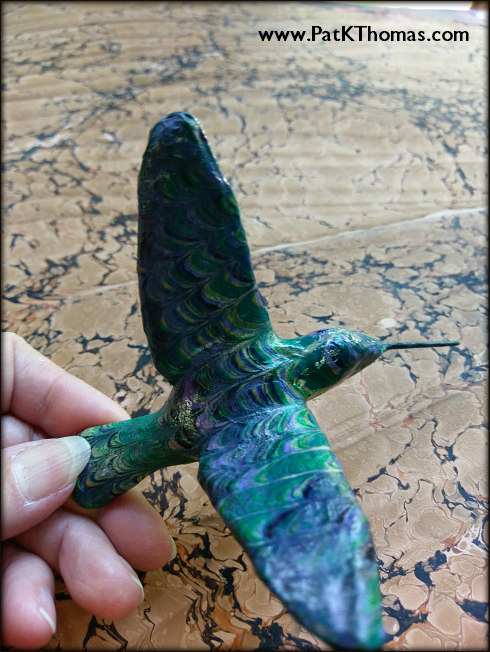
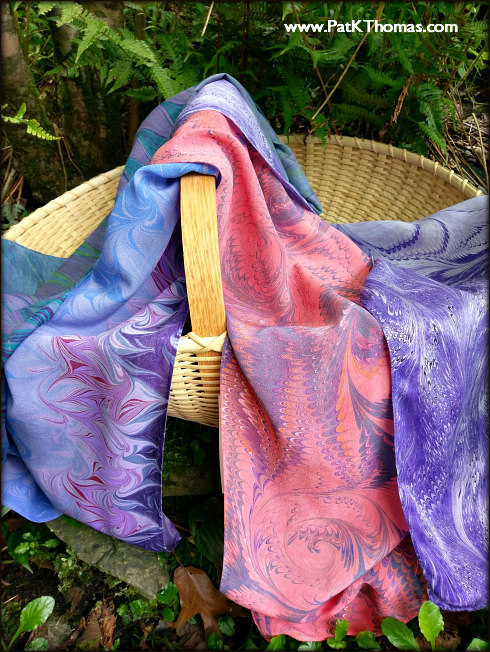
What is the greatest challenge (either technically or mentally) you face when it comes to marbling?
Lately, the greatest challenge to my marbling is finding three days in a row open so I can marble! Life has been busier at the Gallery with fewer workers. The luxury of a whole free week to marble is a thing of the past. Since I am an owner/partner of Cliff Dwellers, I make a range of marbled products for retail sale including full sheets of traditional marbled papers, a variety of books, silk scarves, boxed notecards, my specialty-art wall pieces, and frameable one-of-a-kind contemporary marbling.
What advice would you give to a new marbler or someone thinking about taking up marbling?
My advice to a new marbler is to take as many classes as possible and incorporate the different approaches and find your own voice. Put out the best marbling you can produce because you are representing not only yourself, but a whole history of marblers. Marbling is an archaic art with a rich and varied history over many cultures and centuries. It is my goal to keep marbling fresh and contemporary by re-inventing it for today’s modern, discerning audience. Today’s marblers have the advantage of social media and support groups for questions and inspiration. You Tube is a great teaser, but nothing replaces a hand-on class!
Is there a marbler (or marblers!) whom you admire…and what is it about them that you admire?
I am thankful for Jake Benson, Larissa Don, Robert Wu, and so many others for information and inspiration.
Are you working on any new marbling projects or have any marbling news you are excited to share?
Because of the time commitment of the Gallery and teaching, I only do one major show a year as part of the Foothills Craft Guild I belong to. Recently, I was asked to participate in a fundraiser for the Cancer Support Community in Knoxville, Tenn. What a wild ride that was—speed marbling! Four trays, two 18" x 80" trays and two 24" x 24" trays going every fifteen minutes for three hours with complete novices as marblers! Excellent volunteers were provided as assistants; complete sets of paints in all-new 4-ounce bottles; numbered, pre-determined colorways were selected; and simplified examples of marbled patterns in all the colorways were available to choose from. Forget official names of patterns—enter visual names like feathers, wings, spirals. This event required a tremendous amount of preparation of samples, paints, carrageenan, alummed scarves, directions for the completion of the scarves. But the end result was rewarding!
I’d like to explore publishing my teaching syllabus as a book for my students and the larger marbling community. And there’s that dream I had of the mixed-media apparition that I’d like to pursue…
Anything else you want to share about your experience as a marbler?
Marbling is a state of mind, a lifestyle of color and pattern of past, present, and future. This obscure art form encompasses your waking moments and inhabits your dream world. And I wouldn’t want it any other way!





